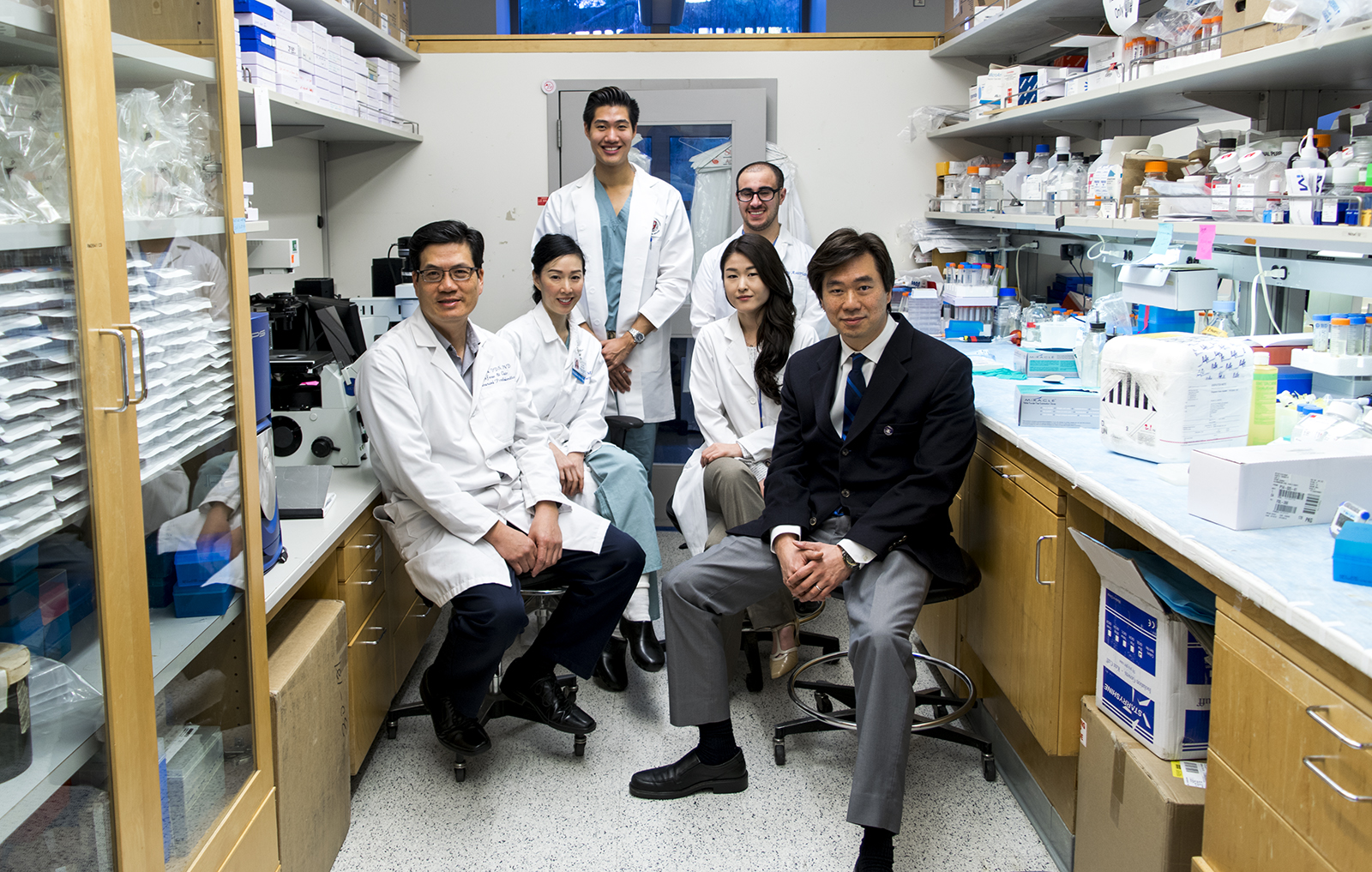Orthopedic research at UCLA to send rodents to space

UCLA researchers and graduate students Dr. Eric Chen (back left), Greg Asatrian (back right), Dr. Benjamin Wu, Dr. Chia Soo, Dr. Jin Hee Kwak and Dr. Kang Ting (front left to right), are studying the effects of osteoporosis in rodents to find a new way to help people suffering from the disease. (Maryrose Kulick/Daily Bruin)
By Allison Ong
Feb. 13, 2015 1:42 a.m.
The original version of this article contained an error and has been changed. See the bottom of the article for more information.
Dr. Chia Soo turns on a video filled with the faces of injured war veterans. In her office on the edge of South Campus, she talks about the challenges of trying to rebuild human bones and nerves as the research director for Operation Mend, a UCLA organization that performs reconstructive surgery on soldiers returning from combat.
“If someone has a significantly mangled extremity that’s missing bone, muscle, nerves and blood vessels, we can’t reconstruct that even with the best plastic surgery,” she said. “How do we begin to better restore form and function to severely injured military personnel?”
Wounded soldiers are one group of patients that Soo, a professor of plastic and reconstructive surgery and orthopedic surgery, and Dr. Kang Ting, a UCLA professor of dentistry, are trying to help by researching advanced treatments for orthopedic disease and deformation. Their two-phase project will ultimately run trials with rodents in space.
The project, already funded by the National Institutes of Health, received a grant last month from the Center for the Advancement of Science in Space to send rodents to the International Space Station, Soo said.
Rodents are the optimal subjects for space trial because they have bony skeletons and can suffer from osteoporosis, a common orthopedic ailment, just as humans do, Soo said.
Soo is leading the research team in ground-based operations at the UCLA lab, optimizing the methods by which the rodents will receive therapy from astronauts aboard the station.
The ground-based phase is now one-third of the way complete, said Dr. Jin Hee Kwak, an adjunct assistant professor of dentistry at UCLA. The cost of the space flight research is estimated to be $133 million.
The project began in 1999 when Ting discovered the NELL-1 gene in humans, a naturally occurring molecule with the power to grow new bone. He isolated the molecule in children with craniosynostosis, a condition in which the sutures in an infant’s skull fuse prematurely and lead to abnormal cranial development.
The discovery prompted Ting and his colleagues to ask themselves how NELL-1 could be translated to human application. The molecule has the potential to treat orthopedic ailments such as cleft palate and extremity fractures by accelerating bone growth and reconstruction.
Dr. Benjamin Wu, a professor of bioengineering and dentistry, modified NELL-1 to treat osteoporosis, according to the press release by CASIS and UCLA.
The team applied for the CASIS grant to conduct space experiments because bone loss occurs at a rate of 1.5 percent per month in zero gravity, Soo said. This would make it easier to analyze how NELL-1 functions.
After the team optimizes treatment on rodents at UCLA, the rodents will fly to the John F. Kennedy Space Center in Florida. One half of the rodents will remain on the ground during the space flight phase to serve as a control group. Both groups will be housed in identical cages replicating the microgravity conditions of space in which all objects float, including food, water and the rodents themselves.
Two students at the UCLA School of Dentistry, Greg Asatrian and Eric Chen, are also members of the research team. Asatrian said he began working there because it combined his clinical, dental and personal interests. He has many family members who experienced osteoporosis, he said.
“I was looking for a research project that I could really see from beginning to end … I had no idea about craniosynostosis when I read about (the space rodent project). I thought it was fascinating,” Asatrian said.
The team is following a detailed timeline created by project manager Kwak to keep the research on track. Because the team is comprised of clinicians, the study is closely integrated with the conditions they see and treat in the office, she said. For example, the professors who work as dentists treat craniofacial deformations in many young children.
“We see the problem in the clinics first,” Kwak said. “(Research) is not a distribution of work (between clinical work and research). You’re being really enthusiastic and passionate about it. It’s your life.”
In the future, the team hopes to use its knowledge to develop marketable treatments for bone restoration, bone loss prevention or bone grafting.
Soo said the project will have specific implications on her work with Operation Mend, perhaps widening the possibilities for reconstructive surgery to include reconstruction of support tissues besides bone.
Ting said he thinks a lifetime commitment to research requires true passion.
“We can see the frustration and devastation that (the soldiers) went through,” Ting said. “It really reminds us constantly why we are doing this.”
If the project proceeds according to schedule, the rodents will launch late 2015 or early 2016.
Correction: Eric Chen’s last name is Chen, not Ting.

